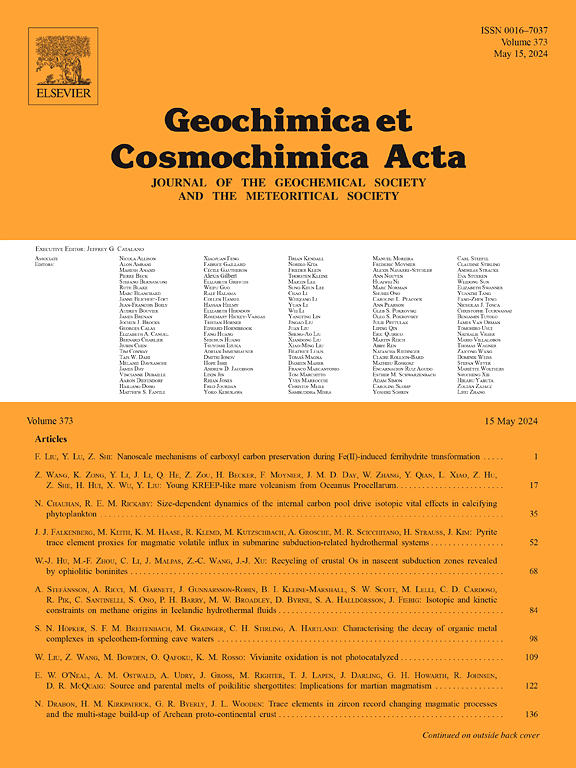HIDALGO: A FUN object from the earliest epoch of the solar system’s history
IF 4.5
1区 地球科学
Q1 GEOCHEMISTRY & GEOPHYSICS
引用次数: 0
Abstract
Chemical and isotopic measurements of HIDALGO, a stoichiometrically pure hibonite inclusion found in the matrix of the Dar al Gani 027 meteorite, were conducted by secondary ion mass spectrometry to investigate its origin and evolution. HIDALGO is characterized by large mass-dependent isotope fractionations in O, Ca, and Ti, as well as large negative anomalies in neutron-rich 48Ca and 50Ti, making it the newest member of the HAL-type FUN inclusions. The highly fractionated Ca and Ti isotopes but unfractionated Mg isotopes are consistent with HIDALGO being a residue from an extensive evaporation event, during which large fractions of initial Ca and Ti, and essentially all the initial Mg, in the precursor material were lost. HIDALGO appears to have incorporated live 26Al at a higher level than other HAL-type inclusions, but still at a lower amount compared to the Solar System’s initial 26Al abundance typically found in non-FUN CAIs. Interestingly, the inferred 10Be abundance in HIDALGO is comparable to the values observed in the majority of CV3 CAIs but ∼ 2.5 times higher than those in HAL-type samples. HIDALGO’s unusual 26Al/27Al and 10Be/9Be ratios, together with the 48Ca-50Ti anomalies, can be best explained by the formation of its precursor material in the isotopically heterogeneous solar nebula. Finally, large 7Li excesses correlating with Be/Li were found in HIDALGO, a behavior that can be interpreted as due to in-situ decay of live 7Be. Charged particle spallation of initially Li-free HIDALGO can simultaneously account for the inferred 7Be abundance and the measured Li elemental concentration. The consistency between the measurement and spallation calculation results provides support for the prior existence of 7Be in HIDALGO, possibly produced by irradiation close to the Sun.
HIDALGO:太阳系历史上最早的FUN天体
HIDALGO 是在 Dar al Gani 027 陨石基质中发现的一种化学计量纯的希波岩包裹体,我们利用二次离子质谱法对它进行了化学和同位素测量,以研究它的起源和演变。HIDALGO的特点是O、Ca和Ti的同位素分馏随质量变化很大,富中子的Ca和Ti也有很大的负异常,使其成为HAL型FUN包裹体的最新成员。高度分馏的 Ca 和 Ti 同位素以及未分馏的 Mg 同位素与 HIDALGO 是大面积蒸发事件的残留物相吻合,在蒸发过程中,前体物质中大量的初始 Ca 和 Ti 以及基本上所有的初始 Mg 都被蒸发掉了。与其他 HAL 型包裹体相比,HIDALGO 似乎含有更多的活 Al,但与太阳系非 FUN CAIs 中通常发现的初始 Al 丰度相比,其含量仍然较低。有趣的是,在HIDALGO中推断出的Be丰度与在大多数CV3 CAI中观测到的数值相当,但比HAL型样本中的Be丰度高出2.5倍。HIDALGO不寻常的Al/Al和Be/Be比率,以及Ca-Ti异常,最好的解释是其前体物质是在同位素异质的太阳星云中形成的。最后,在HIDALGO中发现了与Be/Li相关的大量Li过量,这种行为可以解释为活Be的原位衰变所致。最初不含Li的HIDALGO的带电粒子剥落可以同时解释推断的Be丰度和测量的Li元素浓度。测量结果和溅射计算结果之间的一致性为 HIDALGO 中先前存在 Be 提供了支持,Be 可能是在靠近太阳的地方辐照产生的。
本文章由计算机程序翻译,如有差异,请以英文原文为准。
求助全文
约1分钟内获得全文
求助全文
来源期刊

Geochimica et Cosmochimica Acta
地学-地球化学与地球物理
CiteScore
9.60
自引率
14.00%
发文量
437
审稿时长
6 months
期刊介绍:
Geochimica et Cosmochimica Acta publishes research papers in a wide range of subjects in terrestrial geochemistry, meteoritics, and planetary geochemistry. The scope of the journal includes:
1). Physical chemistry of gases, aqueous solutions, glasses, and crystalline solids
2). Igneous and metamorphic petrology
3). Chemical processes in the atmosphere, hydrosphere, biosphere, and lithosphere of the Earth
4). Organic geochemistry
5). Isotope geochemistry
6). Meteoritics and meteorite impacts
7). Lunar science; and
8). Planetary geochemistry.
 求助内容:
求助内容: 应助结果提醒方式:
应助结果提醒方式:


